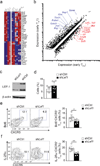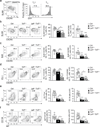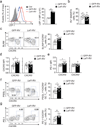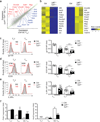LEF-1 and TCF-1 orchestrate T(FH) differentiation by regulating differentiation circuits upstream of the transcriptional repressor Bcl6
- PMID: 26214741
- PMCID: PMC4545301
- DOI: 10.1038/ni.3226
LEF-1 and TCF-1 orchestrate T(FH) differentiation by regulating differentiation circuits upstream of the transcriptional repressor Bcl6
Abstract
Follicular helper T cells (T(FH) cells) are specialized effector CD4(+) T cells that help B cells develop germinal centers (GCs) and memory. However, the transcription factors that regulate the differentiation of T(FH) cells remain incompletely understood. Here we report that selective loss of Lef1 or Tcf7 (which encode the transcription factor LEF-1 or TCF-1, respectively) resulted in T(FH) cell defects, while deletion of both Lef1 and Tcf7 severely impaired the differentiation of T(FH) cells and the formation of GCs. Forced expression of LEF-1 enhanced T(FH) differentiation. LEF-1 and TCF-1 coordinated such differentiation by two general mechanisms. First, they established the responsiveness of naive CD4(+) T cells to T(FH) cell signals. Second, they promoted early T(FH) differentiation via the multipronged approach of sustaining expression of the cytokine receptors IL-6Rα and gp130, enhancing expression of the costimulatory receptor ICOS and promoting expression of the transcriptional repressor Bcl6.
Conflict of interest statement
The authors declare no conflicts of interest.
Figures








References
Publication types
MeSH terms
Substances
Grants and funding
- R21 AI113806/AI/NIAID NIH HHS/United States
- R21 AI105351/AI/NIAID NIH HHS/United States
- T32 AI007485/AI/NIAID NIH HHS/United States
- AI007485/AI/NIAID NIH HHS/United States
- R21 AI119160/AI/NIAID NIH HHS/United States
- S10 RR027366/RR/NCRR NIH HHS/United States
- U19 AI109976/AI/NIAID NIH HHS/United States
- AI112579/AI/NIAID NIH HHS/United States
- AI105351/AI/NIAID NIH HHS/United States
- R01 AI063107/AI/NIAID NIH HHS/United States
- R01 AI112579/AI/NIAID NIH HHS/United States
- AI115149/AI/NIAID NIH HHS/United States
- R01 AI072543/AI/NIAID NIH HHS/United States
- R21 AI115149/AI/NIAID NIH HHS/United States
- AI109976/AI/NIAID NIH HHS/United States
- AI119160/AI/NIAID NIH HHS/United States
- AI072543/AI/NIAID NIH HHS/United States
- AI113806/AI/NIAID NIH HHS/United States
- AI063107/AI/NIAID NIH HHS/United States
LinkOut - more resources
Full Text Sources
Other Literature Sources
Molecular Biology Databases
Research Materials
Miscellaneous

